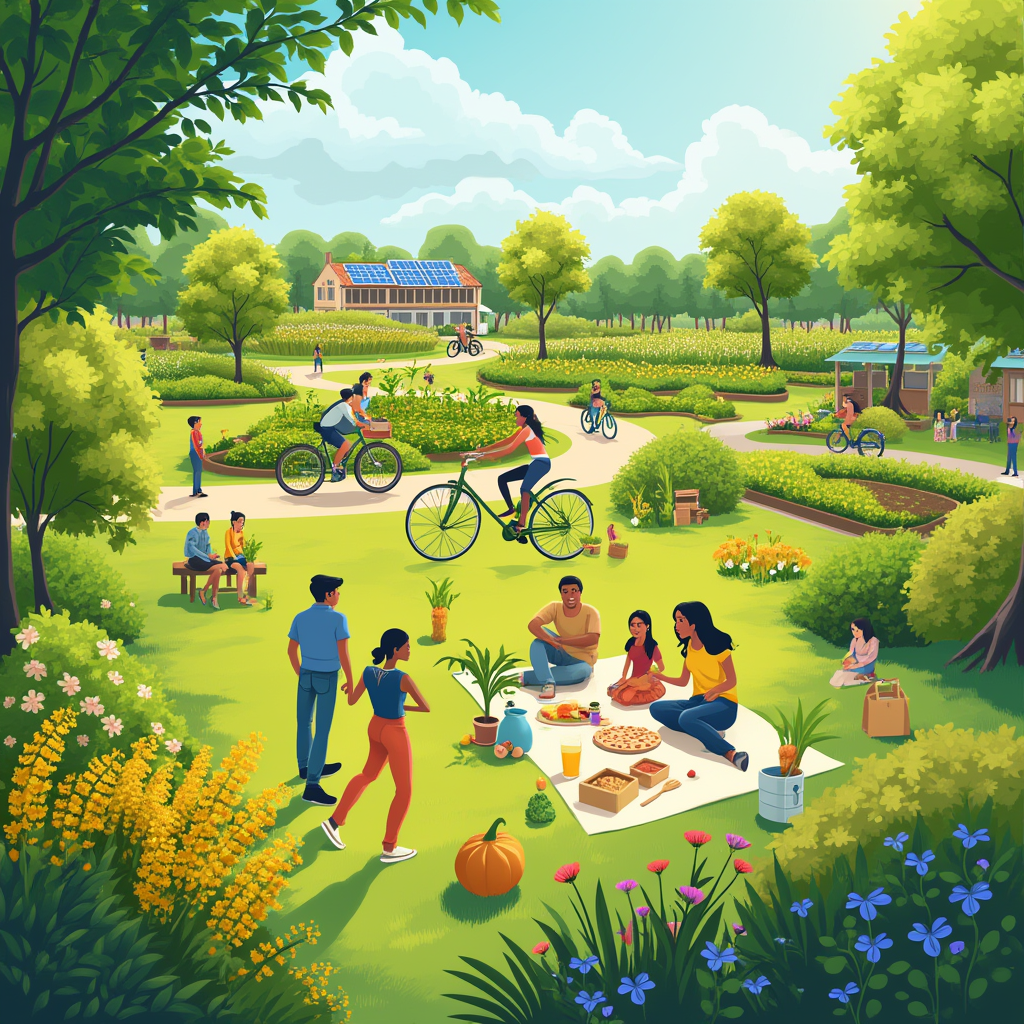What is Going Green?
Going green means making lifestyle changes to reduce our environmental impact through eco-friendly and environmentally responsible practices. These changes include becoming more environmentally aware and changing behavior to minimize waste and pollution [1]. People who go green actively try to reduce their environmental footprint and encourage others to do the same [1].
Environmental consciousness stands as the foundation of going green. This awareness goes beyond basic recycling. People must look at how their daily choices affect resource consumption and environmental impact [2]. Going green recognizes our duty as global citizens in a connected world. We need to learn about practices that protect our environment [2].
Most people don’t transform their lifestyle overnight [1]. This makes sense because changing long-standing daily habits takes time to adjust to environmentally responsible practices [1]. Small changes add up to make a substantial difference in protecting our environment.
Your individual actions play a crucial role in the path toward sustainability. Every step toward sustainable living helps create positive environmental change [1]. Simple lifestyle adjustments benefit Earth and future generations [1]. These personal efforts combine to address major environmental challenges such as climate change, deforestation, and biodiversity loss.
Going green includes these activities:
-
Reducing single-use plastics and waste
-
Conserving energy and water
-
Using public transportation or eco-friendly alternatives
-
Supporting sustainable brands and local businesses
-
Recycling and composting
-
Adopting plant-based diets
Environmental concerns run high, yet actions often fall short. A 2020 Korean consumer survey revealed that 82.2% of respondents wanted to buy eco-friendly products, but only 25.5% actually did [3]. These numbers show how hard it is to turn environmental awareness into daily habits.
Going green aims to achieve environmental balance by using resources at the exact rate at which nature replenishes them [4]. We strive to minimize our carbon footprint through wise choices that benefit our planet and create healthier communities. Environmental consciousness helps us see how all living beings connect. This understanding drives us to protect our delicate ecosystem balance.
Benefits of Going Green
Green practices benefit more than just the environment – they create advantages for you, your community, and the economy. Eco-conscious practices receive more attention, encouraging more positive outcomes that boost our quality of life and the planet’s health.
Being environmentally aware helps your mental health by giving you a sense of purpose and easing eco-anxiety. You can turn abstract environmental worries into tangible actions, which feels liberating psychologically [1]. Your brain releases feel-good chemicals, such as oxytocin and dopamine, during eco-friendly activities. This creates a positive cycle that builds sustainable habits [1]. Time spent in green spaces also lowers your cortisol levels, reduces blood pressure, and lifts your mood [1].
Living sustainably saves money through clever resource use and lower consumption. You can reduce operating costs through energy-efficient practices, renewable energy, and reduced waste [5]. Homes that use energy-efficient appliances, LED lights, and watch their energy use see their utility bills drop [2]. On top of that, it costs less to walk or cycle than to pay for fuel and car maintenance [2].
Eco-friendly choices create healthier living spaces. Using natural, non-toxic products and avoiding harmful chemicals like pesticides and harsh cleaners reduces your exposure to health-damaging toxins [6]. This lowers your risk of developing allergies, breathing problems, and cancer [6].
The economy benefits at both the business and community levels. Companies that adopt green practices adapt more quickly to new market needs and seize opportunities in the green economy [7]. They can separate themselves from competitors, attract eco-conscious customers, and enter new markets by making sustainability core to their strategy [7]. Communities with resilient infrastructure experience economic stability through new local green jobs, lower infrastructure costs, and less property damage from flooding [8].
Better public health and community involvement show the social benefits. People who avoid toxic chemicals in their daily lives help reduce the risk of cancer, asthma, and other respiratory diseases. This puts less strain on healthcare systems [9]. Sustainable living connects you with local communities and like-minded people, fostering teamwork, learning, and sharing ideas [10].
How to Start Going Green in Daily Life
Living green is about taking practical steps that add up to a healthier planet. These actions can become lasting habits that help both the environment and your own well-being.
1. Reduce single-use plastics
Single-use plastics wreak havoc on our environment, especially in marine ecosystems. Without changing our relationship with throwaway items, plastic pollution keeps growing [11]. A single reusable bag can replace more than 500 plastic ones [12]. You can start by saying no to plastic straws, utensils, food containers, and bags. Tell restaurants you don’t want a straw, and skip plastic bottles, cling wrap, and foam takeout containers [13].
2. Save energy at home
Your home’s energy use affects both the environment and your wallet. You can lower your energy bill just by switching off electronics at the wall when they’re not being used [14]. Smart thermostats let you control temperature efficiently without giving up comfort [15]. LED bulbs are amazing—they use 90% less energy and last 15 times longer than regular bulbs [16]. Plugging up cracks keeps warm air from sneaking into your house during summer.
3. Use public transport or bike
Americans use 30% of their energy for transportation, which became the largest source of greenhouse gas emissions in 2016 [17]. Public transit creates fewer emissions per passenger mile than private cars [4]. Sharing rides with just one person cuts your yearly greenhouse gas footprint by 2,000 pounds [4]. People who walk or bike to work have lower chances of getting a stroke, heart attack, or diabetes [4].
4. Eat more plant-based meals
Plant-based foods leave a much smaller environmental footprint. Meat production takes a heavy toll on our planet through water use, pollution, greenhouse gases, and habitat loss [18]. Skipping meat just two or three days a week makes a real difference to your carbon footprint [14]. Try tasty vegan options like black bean-quinoa bowls, cauliflower soup, and lentil dishes—they’re good for you and the environment [19].
5. Recycle and compost
Nature’s way of recycling happens through composting, which helps cut trash and build healthy soil [20]. Food leftovers and yard waste make up more than 28% of our garbage [21]. Home composting keeps waste out of landfills, which are America’s third-largest source of human-made methane [21]. The secret to good composting lies in mixing “browns” (dry leaves and paper) with “greens” (fruit scraps and coffee grounds) [20].
6. Support local and eco-friendly brands
Your shopping choices can encourage businesses to be more environmentally responsible. Look for companies that use eco-friendly materials and ethical manufacturing [3]. Many companies now sell reusable alternatives to single-use products [22]. Shopping at ethical marketplaces helps support businesses that care about the environment and fair labor [23].
7. Conserve water
Small changes in water use add up fast. You can save 3,000 gallons of water each year just by turning off the tap while brushing your teeth [24]. Low-flow showerheads save about 2,700 gallons each year [24]. Outdoor water use is a big deal, since yards and gardens account for 30-60% of household water use, and much of it goes to waste through overwatering [25]. Rain barrels and mulch around plants help keep moisture where it belongs [26].
8. Bring reusable bags and bottles
Your reusable bags and bottles make a real difference. Making one plastic water bottle needs 2,000 times more energy than filling up from the tap [27]. Reusable bottles cut this waste and save you money. Cloth shopping bags help fight plastic pollution, too. Build a zero-waste kit with reusable utensils, napkins, food containers, coffee mugs, water bottles, shopping totes, and produce bags [13].
Why Going Green Can Be Challenging
People understand the need to protect our environment, but adopting green practices faces big challenges. Many barriers stop people from embracing eco-friendly behaviors, even when they know why going green matters.
Lack of access to green alternatives
Location and income levels limit green options for many people. Low-income and BIPOC communities don’t have enough access to green spaces, which makes health gaps worse [9]. These communities have fewer outdoor recreation resources, making it hard to find information or support [9]. Past practices such as redlining and income-based segregation created an unfair distribution of natural spaces [9]. So, places like Qatar keep energy prices very low (USD 0.03 per kWh compared to Germany’s USD 0.46), which gives people little reason to save energy [2].
Higher upfront costs
Money is the biggest obstacle to sustainable living. Research shows that costs prevent people from living healthier and more sustainably, with 49% of people in 25 countries worried about affordability [28]. While many buyers want eco-friendly options, 49% won’t pay extra for them [29]. Green products cost more because everything — from raw materials to certification — is more expensive than for regular products [29].
Cultural and peer pressure
Social norms shape how people act on sustainability. About 26% of Indian consumers say their family’s disapproval keeps them from buying sustainable products [30]. Around the world, 45% of consumers admit that social and psychological barriers block green choices [30]. In the UK, 16% avoid eco-friendly changes due to cost, while 15% need more information before changing their lifestyles [31].
Time and convenience factors
Today’s busy lifestyle creates significant time pressures that block green practices. People who lack time spend more money on easy but unsustainable options [32]. Green habits often clash with work-life and free-time priorities [32]. To name just one example, convenience stops people from cutting back on home deliveries, saving water, reducing food waste, and switching to cleaner transport [6]. Convenience ranks as the third most crucial barrier to sustainable living at 11.2% [33].
Key Takeaways
Going green is a gradual journey of adopting eco-friendly practices that benefit both the environment and personal well-being. Here are the essential insights for starting your sustainable living journey:
• Start small with daily swaps: Replace single-use plastics with reusable alternatives and turn off electronics when not in use to reduce environmental impact immediately.
• Transportation choices matter most: Use public transport, bike, or carpool to cut greenhouse gas emissions by up to 2,000 pounds annually while improving personal health.
• Plant-based meals reduce footprint: Eating less meat, even 2-3 days weekly, significantly decreases your carbon footprint and environmental impact.
• Financial benefits follow green choices: Energy-efficient practices and sustainable living reduce utility bills and long-term expenses despite higher upfront costs.
• Overcome barriers with planning: Address challenges like cost, convenience, and access by creating zero-waste kits and supporting local eco-friendly businesses.
The key to successful green living lies in making incremental changes that, together, create a significant environmental impact. While barriers such as cost and convenience persist, the long-term benefits—including improved mental health, financial savings, and environmental protection—make the transition worthwhile for individuals and communities alike.
FAQs
Q1. What are some simple ways to start living a more eco-friendly lifestyle? Start by reducing single-use plastics, conserving energy at home, using public transport or biking, eating more plant-based meals, and recycling. These small changes can significantly reduce your environmental impact and often lead to cost savings as well.
Q2. How does going green benefit me personally? Going green can improve your mental health by reducing eco-anxiety, save you money through reduced energy consumption, create healthier living environments by avoiding toxic chemicals, and foster community engagement. It also contributes to better public health and can provide a sense of purpose.
Q3. Is it expensive to adopt an eco-friendly lifestyle? While some eco-friendly products may have higher upfront costs, many green practices actually save money in the long run. Energy-efficient appliances, reducing waste, and conserving resources like water and electricity can lead to significant savings on utility bills and everyday expenses.
Q4. How can I make my diet more environmentally friendly? Incorporate more plant-based meals into your diet. Even reducing meat consumption for 2-3 days a week can make a considerable difference in lowering your carbon footprint. Try simple vegan meals like bean-quinoa bowls or lentil dishes as nutritious and delicious alternatives.
Q5. What are some challenges in maintaining an eco-friendly lifestyle? Common challenges include limited access to green alternatives, higher upfront costs for some eco-friendly products, social and cultural pressures, and time constraints. However, planning, creating zero-waste kits, and gradually incorporating sustainable habits can help overcome these obstacles.
Our carbon experts help production studios frame strategy, train teams and track results — tailored to operational constraints.


![How to Claim Canadian Film or Video Production Tax Credit [Expert Guide 2025]](https://www.thegreenshot.io/wp-content/uploads/2025/12/how-to-claim-canadian-film-or-video-production-tax-credit-expert-guide-2025-300x171.webp)


